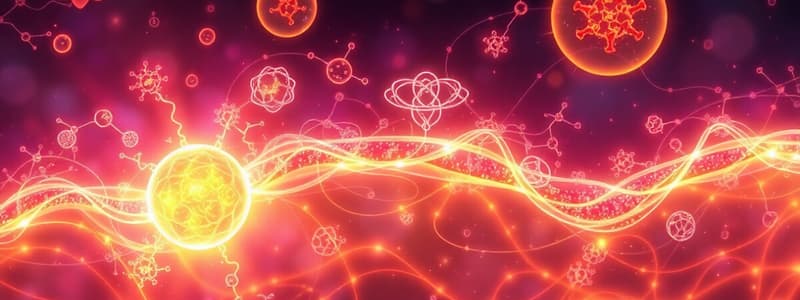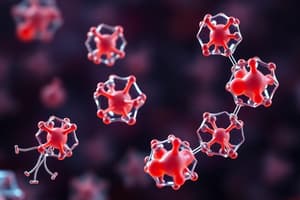Podcast
Questions and Answers
What is the primary function of the urea cycle?
What is the primary function of the urea cycle?
- To produce proteins from amino acids
- To store excess nitrogen in the body
- To convert urea into ammonia
- To convert toxic ammonium ion into less toxic urea (correct)
Carbamyl phosphate is generated from the reaction of free ammonium ion with bicarbonate.
Carbamyl phosphate is generated from the reaction of free ammonium ion with bicarbonate.
True (A)
What is the role of N-Acetylglutamate in the urea cycle?
What is the role of N-Acetylglutamate in the urea cycle?
It regulates the rate-limiting enzyme, CPS 1.
The enzyme that converts carbamyl phosphate into citrulline is called __________.
The enzyme that converts carbamyl phosphate into citrulline is called __________.
Match the following components of the urea cycle to their functions:
Match the following components of the urea cycle to their functions:
What happens during hyperammonemia?
What happens during hyperammonemia?
Arginine can be converted directly to urea and ornithine in the urea cycle.
Arginine can be converted directly to urea and ornithine in the urea cycle.
What is the role of urea precursors in the urea cycle?
What is the role of urea precursors in the urea cycle?
What is the role of N-Acetylglutamate Synthetase in the urea cycle?
What is the role of N-Acetylglutamate Synthetase in the urea cycle?
Nitrogen sources for the urea cycle include only free ammonium ions.
Nitrogen sources for the urea cycle include only free ammonium ions.
What does N-Acetylglutamate activate in the urea cycle?
What does N-Acetylglutamate activate in the urea cycle?
The urea cycle is primarily regulated by the availability of __________ substrates.
The urea cycle is primarily regulated by the availability of __________ substrates.
Match the following components of the urea cycle with their roles:
Match the following components of the urea cycle with their roles:
What is the characteristic finding in blood tests for diagnosing hyperammonemia?
What is the characteristic finding in blood tests for diagnosing hyperammonemia?
Early recognition and prompt treatment of hyperammonemia are essential to prevent neurological complications.
Early recognition and prompt treatment of hyperammonemia are essential to prevent neurological complications.
Name one pharmacological agent used to treat hyperammonemia.
Name one pharmacological agent used to treat hyperammonemia.
Dietary interventions for managing hyperammonemia typically involve limiting __________ intake.
Dietary interventions for managing hyperammonemia typically involve limiting __________ intake.
Match the management strategies with their purpose:
Match the management strategies with their purpose:
What additional tests may be necessary in the diagnosis of hyperammonemia?
What additional tests may be necessary in the diagnosis of hyperammonemia?
Elevated ammonia levels alone are sufficient for diagnosing hyperammonemia.
Elevated ammonia levels alone are sufficient for diagnosing hyperammonemia.
What is the primary goal of managing hyperammonemia?
What is the primary goal of managing hyperammonemia?
In severe cases of hyperammonemia, __________ may be necessary to rapidly remove excess ammonia.
In severe cases of hyperammonemia, __________ may be necessary to rapidly remove excess ammonia.
What is a serious consequence of untreated hyperammonemia?
What is a serious consequence of untreated hyperammonemia?
What is the primary function of ornithine transcarbamylase (OTC) in the urea cycle?
What is the primary function of ornithine transcarbamylase (OTC) in the urea cycle?
The formation of carbonyl phosphate is the final step in the urea cycle.
The formation of carbonyl phosphate is the final step in the urea cycle.
What condition can arise from a deficiency in OTC activity?
What condition can arise from a deficiency in OTC activity?
The first enzyme in the urea cycle is Carbamylphosphate Synthetase 1 (CPS 1), which produces __________.
The first enzyme in the urea cycle is Carbamylphosphate Synthetase 1 (CPS 1), which produces __________.
Match the following terms with their descriptions:
Match the following terms with their descriptions:
Which of the following intermediates is formed as a result of the action of OTC?
Which of the following intermediates is formed as a result of the action of OTC?
OTC is located in the cytoplasm of the cell.
OTC is located in the cytoplasm of the cell.
What is the main consequence of OTC deficiency in terms of ammonia?
What is the main consequence of OTC deficiency in terms of ammonia?
The product of the first step of the urea cycle, which is catalyzed by CPS 1, is __________.
The product of the first step of the urea cycle, which is catalyzed by CPS 1, is __________.
How does the location of OTC and CPS 1 within the mitochondria benefit the urea cycle?
How does the location of OTC and CPS 1 within the mitochondria benefit the urea cycle?
Where do the first two enzymes of the urea cycle primarily reside?
Where do the first two enzymes of the urea cycle primarily reside?
The urea cycle occurs solely in the cytoplasm of liver cells.
The urea cycle occurs solely in the cytoplasm of liver cells.
What is the primary function of the urea cycle?
What is the primary function of the urea cycle?
The waste product ammonia is converted into __________ through the urea cycle.
The waste product ammonia is converted into __________ through the urea cycle.
Match the enzymes with their locations in the urea cycle:
Match the enzymes with their locations in the urea cycle:
What compound is formed when carbamylphosphate reacts with ornithine?
What compound is formed when carbamylphosphate reacts with ornithine?
The urea cycle is also known as the ornithine cycle.
The urea cycle is also known as the ornithine cycle.
How many enzymatic reactions comprise the urea cycle?
How many enzymatic reactions comprise the urea cycle?
The toxic compound that is converted to urea in the liver is __________.
The toxic compound that is converted to urea in the liver is __________.
Which enzyme is responsible for the initial reaction of ammonia and bicarbonate in the urea cycle?
Which enzyme is responsible for the initial reaction of ammonia and bicarbonate in the urea cycle?
Flashcards are hidden until you start studying
Study Notes
The Urea Cycle
- the urea cycle converts toxic ammonium ions into less toxic urea
- the urea cycle occurs primarily in the liver
- it is a series of five enzyme-catalyzed reactions that eliminate excess nitrogen from the body
- the urea cycle enzymes are located in both the mitochondria and cytosol of liver cells
- the first two enzymes, Carbamylphosphate Synthetase 1 (CPS 1) and Ornithine Transcarbamylase (OTC), are found in the mitochondrial matrix
- the remaining three enzymes, Argininosuccinate Synthetase, Argininosuccinate Lyase, and Arginase, are located in the cytosol
Key Urea Cycle Enzymes
- CPS 1 is the rate-limiting enzyme of the urea cycle
- CPS 1 is regulated by N-Acetylglutamate
- OTC converts carbamyl phosphate into citrulline
Process of the Urea Cycle
- Ammonium ion + Bicarbonate → Carbamylphosphate (via CPS 1)
- Carbamylphosphate → Citrulline (via OTC)
- Citrulline → Argininosuccinate (via Argininosuccinate Synthetase)
- Argininosuccinate → Arginine (via Argininosuccinate Lyase)
- Arginine → Urea (via Arginase)
- Urea → Ornithine (via Arginase)
Activation of the Urea Cycle
- The urea cycle is activated by the flow of nitrogen
- The enzyme N-Acetylglutamate Synthetase generates N-Acetylglutamate, which activates CPS 1
- N-Acetylglutamate Synthetase stimulates the conversion of ammonium ions and bicarbonate into carbamylphosphate
Hyperammonemia
- Hyperammonemia is a condition of elevated ammonia levels in the blood
- Hyperammonemia can be caused by deficiencies in the urea cycle enzymes
- OTC deficiency is one of the most common urea cycle disorders
- Hyperammonemia can lead to neurological complications, including death
Treatment of Hyperammonemia
- Treatment strategies involve reducing ammonia levels and preventing further accumulation
- Dietary interventions, such as limiting protein intake, can help reduce ammonia production
- Pharmacological agents can facilitate the alternative pathways for nitrogen excretion, bypassing the urea cycle
- Dialysis or other forms of extracorporeal blood purification may be necessary to remove excess ammonia from the body
- Addressing the underlying cause is crucial for the long-term management of hyperammonemia
Studying That Suits You
Use AI to generate personalized quizzes and flashcards to suit your learning preferences.




